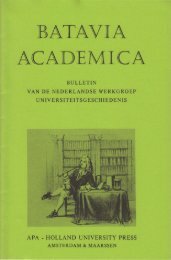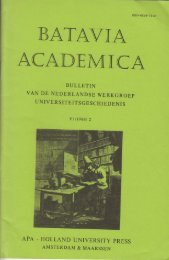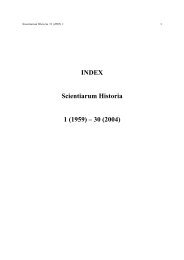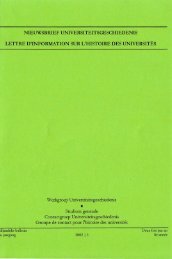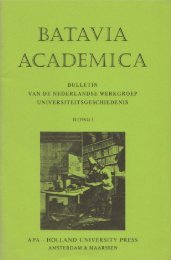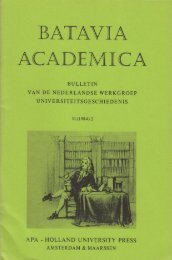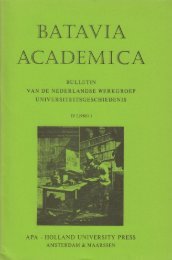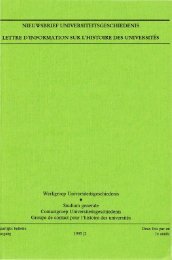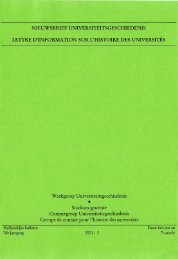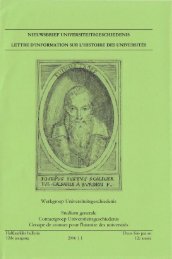the ocular harpsichord of louis-bertrand castel - Gewina
the ocular harpsichord of louis-bertrand castel - Gewina
the ocular harpsichord of louis-bertrand castel - Gewina
Create successful ePaper yourself
Turn your PDF publications into a flip-book with our unique Google optimized e-Paper software.
Castel's <strong>ocular</strong> <strong>harpsichord</strong> 27<br />
... <strong>the</strong> great Newton, how could he have been so deeply wrong, and with that apparatus and that<br />
fuss that impresses <strong>the</strong> wise and keeps <strong>the</strong> universe in admiration and as it were enslaved by its<br />
brilliant spectrum <strong>of</strong> seven colours, no more, no less'.' ... I had challenged <strong>the</strong> prism and its<br />
fantastic spectrum ... I regarded it with terror, as if it were a reef signaled by <strong>the</strong> wreckage <strong>of</strong> a<br />
famous ship, followed by a thousand ships that had come to share its disaster, while collecting<br />
its debris.'*<br />
In his later book on Newtonian physics in general, Castel tried to give a <strong>the</strong>oretical<br />
foundation to his critique <strong>of</strong> Newton's optics.** He presented some objections<br />
against <strong>the</strong> emission <strong>the</strong>ory <strong>of</strong> light (he had never discussed it before). For<br />
instance, it could not explain how objects could have a blue colour; if <strong>the</strong> surface<br />
<strong>of</strong> an object absorbs <strong>the</strong> larger and heavier red light-particles, it will surely also<br />
absorb <strong>the</strong> smaller blue light-particles, instead <strong>of</strong> reflecting <strong>the</strong>m. Referring to<br />
Malcbranche's <strong>the</strong>oiy, in which light is a sequence <strong>of</strong> pulses, or a vibration, in a<br />
special medium, <strong>the</strong> ae<strong>the</strong>r, Castel argued that both white and coloured light arc<br />
vibrational phenomena. White light is a single, longitudinal vibration, and<br />
coloured light results when a second transverse vibration is added to <strong>the</strong><br />
vibration <strong>of</strong> white light. In such a model, where coloured light is a modification<br />
<strong>of</strong> white light, it is conceivable that <strong>the</strong> light that passes through a prism gets<br />
coloured only at <strong>the</strong> edges; in <strong>the</strong> middle <strong>of</strong> <strong>the</strong> beam <strong>the</strong> transverse vibrations<br />
annihilate each o<strong>the</strong>r, while <strong>the</strong>y can survive at <strong>the</strong> edges.'*"<br />
Castel's attempts actually to build an <strong>ocular</strong> <strong>harpsichord</strong><br />
In nei<strong>the</strong>r <strong>the</strong> "Nouvelles experiences" nor <strong>the</strong> Optique des couleurs did Castel<br />
seriously discuss <strong>the</strong> actual construction <strong>of</strong> an <strong>ocular</strong> <strong>harpsichord</strong>. In his 1735<br />
article he ended with an enormously elaborate extension <strong>of</strong> his earlier pro<strong>of</strong><br />
more geometrico <strong>of</strong> <strong>the</strong> po.ssibility <strong>of</strong> colour music, building it into a complete<br />
"logique du gout" with eight principal propositions and 73 <strong>the</strong>orems, and finally<br />
lost himself in a delirious enumeration <strong>of</strong> all possible kinds <strong>of</strong> colour enjoyment.<br />
Never<strong>the</strong>less, from some occasional remarks it becomes clear that Castel had<br />
Ibid., pp. 373-374, 376-377: "le grand Newton, pourquoi & comment a-t-il pu s'y tromper<br />
solemnellement. & avec cet appareil & ce fracas qui impose aux sages, & tient tout I'univers dans<br />
I'admiration & prcsque dans I'esclavage de son spectre essentiellement brillant de 7 couleurs, ni plus<br />
ni moins? ... Je me defiois du prisme & de son spectre fantastique ... Je le regardois avec terreur,<br />
comme un ecueil signale par le naufrage d'un vaisseaux fameux, suivi de mille vaisseaux, qui<br />
venoient a I'envi partager .son desastre, en recueillant ses debris."<br />
39<br />
Castel, Le vrai systeme, pp. 421-500.<br />
40<br />
Ibid., pp. 501-507. Malebranche had included <strong>the</strong> first version <strong>of</strong> his <strong>the</strong>ory in <strong>the</strong> 1700 edition<br />
<strong>of</strong> his De la recherche de la verite, but presented a slightly but significantly changed version in <strong>the</strong><br />
1712 edition, to make it compatible with Newton's prism experiments. See Hakfoort, Optica, pp. 60-<br />
63. Castel apparently had read, or digested, only <strong>the</strong> 1700 version.



